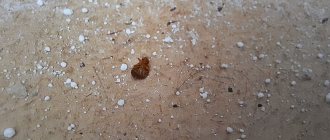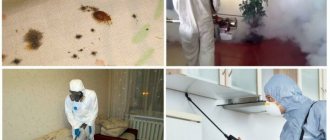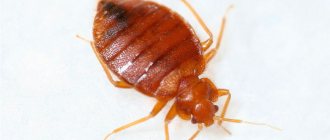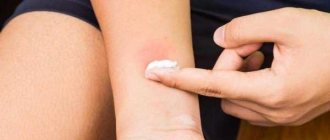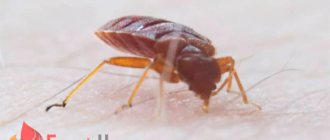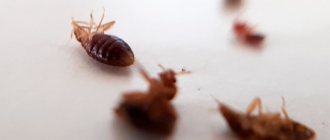Normally, after good quality treatment, bedbugs die within an hour or two, and in another 1-2 days those insects that were not directly affected by the insecticide during treatment are poisoned.
Bed bugs collected immediately after treatment
According to SanMariDez statistics, after 67% of our treatments not a single living bug is found within 2-3 hours after disinfestation, in 14% of treatments the bedbugs live for another 1-2 days, after which they disappear, in 3% of treatments they die on the third or fourth day, and in other cases they either do not die completely, or appear again during the first week and need to be poisoned again.
For the most part, after baiting, bedbugs die when they try to get out of their shelters at night and find a sleeping person, and in their movements crawl through a layer of dried insecticide. Since conscientious disinfectors always use preparations with a long residual effect to bait bedbugs, it is not particularly important how long it takes for these unsprayed bedbugs to get out of their nests - they cannot do this less than once every 4-5 days, since exactly once every 4-5 days they feed, and high-quality insecticides continue to act for 2-3 weeks after application to the surface and drying.
But this is normal. According to our statistics, approximately 22-23% of situations go beyond the limits of this norm, and in these cases, in apartments, houses or work premises, bedbugs either die after treatment a little longer, or some of them live a long time and in order to exterminate them it is necessary to carry out repeated disinfestation .
We deal with all these situations very carefully, since it is extremely important for us to maximize the number of treatments, after which the bedbugs die quickly and do not appear again. To do this, we take into account not only our experience, but also the experience of our clients who poisoned bedbugs themselves before contacting us, or ordered treatments from other specialists (or not quite specialists).
Thanks to this, we know almost all the reasons why these parasites can survive in premises after disinfestation, and we take them into account when our specialists go out for disinfection. And by looking at how long bedbugs live in an apartment after treatment, you can understand why they actually live and do not disappear immediately. Here's how we define it:
How do bedbugs behave after treatment?
The behavior of parasites after treatment depends on:
- composition of the drug used for disinfestation;
- the concentration of the insecticide that fell directly on the insect;
- accessibility of nests for direct penetration of chemicals into them.
Modern drugs have a complex composition of several components with different mechanisms of action on parasites.
After baiting bedbugs, you can observe the following:
- Some drugs cause rapid death of insects, and some of them die directly during disinfestation.
- It feels like there are a lot more parasites. This is wrong. Insects begin to run out of treated shelters and try to look for new ones, including from neighbors.
- Bedbugs become more active, appear during the daytime, and hide in unusual places. This is the effect of insecticides aimed at paralyzing the nervous system. Gradually, the activity of the parasites decreases, disorientation appears, and then the death of the insects.
Bedbugs that have received a tiny dose of poison continue their normal lifestyle. They can also bite at night and reproduce in nests that go undetected during treatment.
About low-quality means of exterminating bedbugs
Today it is impossible to remove bedbugs without professional means. Modern insecticides have an immediate effect on parasites and a long period of action: up to six months. Many pest control services today offer bedbug extermination services using outdated means. Experts note that the remedies that were relevant 10 years ago are not 100% effective today. Therefore, when starting to poison bedbugs, be careful and make sure that modern treatment preparations are used. If you call a professional, be sure to ask for a guarantee for pest control and remember that high-quality chemicals are not cheap.
On what day after disinfestation do bed bugs disappear?
None of the manufacturers of pesticides will say exactly how long bedbugs live after being treated with it. It depends on many factors. A drug that gets directly onto the body of the parasite can cause rapid death of the insect. It is absorbed through the outer skin and respiratory tract.
Corpses
In this way, it is possible to destroy part of the bedbug population. The life expectancy of the remaining individuals is from one to two weeks, depending on the composition of the drug, the quality of processing and the stage of development of the insect.
Some bedbugs survive even the most thorough disinsection if they have previously developed immunity to the type of insecticide used.
Treatment of a room without professional equipment suffers from lower quality and it is not possible to unequivocally answer the question of how many days the bedbugs will disappear. You can notice insects crawling around the apartment even after two weeks.
Aerosol and liquid preparations have a faster effect compared to powders. For example, when using Tsifoks, the bug dies in 20–30 minutes, and Dust Absolute will cause the death of most insects in a few days.
Features of life
Bedbugs adapt very well to environmental conditions. Blood-sucking insects are quite difficult to remove in one go. For bedbugs to go away, it takes patience and the right approach to treating the room. Before you begin the procedure, you must familiarize yourself with the following facts:
- insects are able to move throughout the entire territory in search of a person;
- under the influence of low temperatures, bedbugs hibernate;
- high temperatures are detrimental to parasites; washing clothes and linens at temperatures of 90 degrees and above can kill insects;
- a female bedbug lays from 300 to 500 eggs throughout her life;
- even in the absence of food, bedbugs can live for several months;
- high-quality treatment does not guarantee instant relief from parasites; bedbugs can live for another two to three weeks.
Bedbug death temperature
If insects do not have enough food, they can fall into a state of suspended animation and remain for a year and a half, then wake up and begin to bite a person again.
All these factors explain the fact that the death of bedbugs does not occur immediately after disinfestation.
How to get rid of odor after disinfestation?
Manufacturers of bedbug repellents offer unscented, fragranced or regular options. When choosing the first two options, you need to take into account that they are most likely less toxic to bedbugs, having their own aroma, albeit a weak one.
To get rid of the first pungent odor after baiting bedbugs, after finishing the treatment you need to ventilate the room closed for conservation. It is necessary to create a draft and, if possible, not stay in the apartment. In winter, initial ventilation should take at least 1–2 hours, depending on the outside temperature. In summer - 3–4 hours.
Carpets and textiles retain the smell for a long time after disinsection. Therefore, it is better to immediately remove the curtains and wash them, and clean the carpets with a damp brush. You can't do any general cleaning for another two to three weeks.
The concentration of unpleasant odor can be reduced by eliminating the remains of bedbugs, but only using the dry method, and daily ventilation.
The unpleasant aroma will finally disappear after general cleaning and cleaning of furniture covers.
Attention! If you need to get rid of the smell urgently, then you can additionally order deodorization of the premises from the same organizations that do the treatment of premises. It must be borne in mind that this will reduce the effect of disinfestation.
Was the processing done well?
Often bedbugs remain after treatment due to improper preparation for removing insects. In order for disinfestation to produce results, the following rules should be followed:
- Remove food, as well as anything that could spoil if it comes into contact with the insecticide, out of the house.
- Provide free access to areas where bedbugs spread: beds, cabinets, baseboards, etc.
- Carefully treat beds, baseboards, cracks
- Leave the room for 1.5-2 hours after treatment
- After returning, ventilate the apartment, remove dead insects and their eggs
- Wipe frequently used surfaces with a dry cloth; under no circumstances do wet cleaning for a week.
In addition, do not forget to treat the entire apartment with drugs, and not just bedbug nests. If there are untreated areas left in the room, the parasites will definitely occupy them, establishing their colonies there.
Reasons why bedbugs may remain indoors after treatment
If the bedbugs do not disappear after treatment, but continue to bite at night, then there may be several reasons for this:
- Too little time passed, and the drug did not have time to act on all individuals.
- Poor preparation of the premises for disinfestation. For example, during treatment, some bedbugs remained under the dust and were not exposed to poison.
- Spraying was carried out with violations. Not all shelters have been processed.
- A low-quality product was used, or the solution was made too weak.
- Bedbugs have already been treated with a similar drug, and they have acquired immunity. In this case, the bedbugs do not disappear, but continue their normal lifestyle.
- Repeated disinfestation was not carried out and a new generation of bedbugs appeared.
- General cleaning was done before the recommended time had expired, which allowed some individuals to survive.
- After treatment, the bedbugs disappeared for some time, and then appeared again. Most likely, they returned from their neighbors, who also started destroying them. This happens quite often if preventative work has not been carried out in the apartment.
Preparing the premises
Why didn't the drugs work?
It is impossible to say with certainty whether bedbugs will die after disinfection. Survival depends on many factors. If all even the most secluded corners have been well treated, the chance of quickly getting rid of parasites increases.
Adults disappear, but their newly emerged larvae will be alive. Parasites rarely disappear immediately; it will take time. Newly appearing individuals will die after some time, since the effect of modern insecticides is long-lasting. Do not rush and do general cleaning immediately after treatment.
The reason why the bedbugs did not die may be an incorrect approach to the procedure. Re-infestation of the apartment will occur if all corners have not been thoroughly treated and places where insects accumulate have not been identified.
An incorrectly selected insecticide may not work. It is better to choose modern drugs, since insects have developed a strong immunity to old-generation insecticides.
It is important to identify the cause of the appearance of insects; as a rule, they are brought into the apartment by people; bedbugs themselves cannot travel significant distances. It is necessary to analyze where parasites can be brought into the house from, otherwise, after destruction, the insects will be brought again and the infection will repeat.
It is possible that the bedbugs came from neighbors; in this case, it is advisable to carry out treatment in all neighboring apartments.
To avoid re-infection, it is better to entrust the work to professional services.
In what cases is re-processing necessary?
Repeated disinfection of the premises is almost always recommended. There are very rare cases when it is possible to remove bedbugs the first time and for a long time. Experts advise doing it two to three weeks after the previous one. But if one and a half to two months have passed after the first treatment, and the bugs do not disappear, then the question of whether to carry out or not disappears by itself.
When repeating disinfestation, you must:
- Change the drug to another. If bedbugs remain after treatment, it is possible that they are resistant to the device used. Most often this happens in apartment buildings where neighbors poison insects. In private households, this happens after repeated attempts to get rid of parasites.
- Conduct a re-inspection of the premises aimed at finding undetected nests.
You can carry out repeated treatment against bedbugs yourself in cases where the number of insects has decreased significantly after the first disinfestation. It does not require such large-scale actions as the previous one.
Vitality of parasites
Domestic bloodsuckers are endowed with increased adaptability to negative external factors, which is why their destruction is so problematic. It is impossible for insects to disappear without outside intervention. A number of factors from the life of parasites:
- They move freely around a living space and look for a victim anywhere.
- They feed on human blood, but in the absence of a source they do not die, but fall into suspended animation (comatose state). They can remain in this form for up to a year or longer. Smelling fresh blood, they wake up and function with no less vivacity.
- Exposure to low temperatures puts you to sleep.
- They reproduce intensively. In one go, the female lays up to 30 eggs, and in a lifetime - about 500. The development of the embryo lasts only 4 days, then the larva hatches and a month later an adult insect is formed.
- Even after professional disinfestation of a residential property, the eggs remain untouched for another 2-3 weeks.
Having analyzed such qualities of insects, it is clear why they do not die immediately after the first sanitation. Repeated is necessary to destroy nymphs emerging from egg clutches.
Destruction of the entire population
In a private home, killing insects usually does not cause problems. Some time after the first and repeated treatment, all bedbugs die. In rare cases, when the house is old and there are many hiding places where it is difficult to reach, several disinsections may be required in a row at certain intervals.
In an apartment building, achieving this effect is much more difficult, since all rooms need to be treated simultaneously, including basements and attics. There, insects can temporarily take refuge until the situation stabilizes and the poisons stop working. Otherwise, bedbugs will migrate from one apartment to another ad infinitum. For processing of this scale, SES is most often involved.
Professional processing
How long should I wait
In many ways, the death of insects depends on the quality of disinfestation. Even analyzing the features of the room, identifying areas where bed bugs accumulate, and thoroughly treating bedding and furniture cannot guarantee that bed bugs will stop biting. These insects like to hide in secluded places, especially to lay larvae there.
To understand why bed bugs still bite after treatment, you need to know two important points regarding the life activity of this species:
- Each female lays up to 20 eggs at one time, and up to 500 throughout her life;
- Development in the egg lasts several days, and the adult becomes an adult within a month.
Such scientific data suggests that a month is the minimum period for completely getting rid of bedbugs. During this period, it will not be possible to avoid insect bites. Additional treatment of the premises after a couple of weeks will help to significantly reduce the number of bed bugs and consolidate the effect of the first disinfestation.
Prevention of re-infection
You can avoid re-infection of the premises if you take preventive measures:
- Seal all the cracks through which bedbugs can enter the apartment. Seal the ventilation shaft with mosquito netting. Do not open windows and balcony doors without a mosquito protection frame. Check the tightness of the seal on the entrance doors.
- Constantly use barrier protection against bedbugs entering your home.
- After trips, when you had to stay in hotels, hostels or private apartments, immediately wash all items at high temperature.
- Periodically steam your pet's bed if he is outdoors.
These simple measures will help save nerves and effort, which can be used to get rid of insects.
Carrying out repeated disinfestation
Repeated disinsection is practically no different from the first treatment.
Like the primary disinfection treatment, the secondary one takes place in several stages. It's best done by professionals:
- The specialist assesses the level of infection, determines the most dangerous places;
- The apartment is prepared: food and personal belongings are removed, furniture is moved to the center, passages to walls and corners are cleared, as well as to all places where bedbugs were found;
- Select a suitable remedy: since one poison has already been used, it is necessary to use another;
- Residents with a child or pets leave for the duration of treatment, after which the exterminator tightly closes the windows and doors and begins to disinfect;
- After a set time (at least 3 hours), you can ventilate the room and begin cleaning and disinfection.
Important! Within a few days you will need to thoroughly clean the room: the bedbugs will crawl out and die. It is necessary to throw away both dead and half-living insects. When using a vacuum cleaner, you will need to regularly shake it out and take out the trash.
Do bedbugs bite painfully?
Bedbugs bite painlessly, and this is due to the biological components contained in their saliva. When the proboscis is inserted into the skin through one of the stylets, the bug immediately injects a mixture of biochemical substances that help it freely suck blood. These components include vasodilating proteins, anticoagulants, which prevent blood clotting in the puncture area, as well as anesthetics, under the influence of which a person does not feel pain during a bite.
What does bedbug saliva contain?
An analysis of the content of various proteins in the saliva of bed bugs was carried out by a group of scientists from the American National Institute of Allergy and Infectious Diseases and the University of Kentucky. A total of 46 proteins were identified, some of which are found in all blood-sucking arthropods, but some proteins are characteristic only of bedbugs (Cimex lectularius).
For example, nitrophorin is a hemoprotein that transports nitric oxide (NO) to tissues, causing dilation of blood vessels. Also, to the surprise of scientists, the saliva of bedbugs turned out to have a pronounced content of acetylcholinesterase, an enzyme that is usually found in synapses and regulates the vital functions of the nervous system. The action of neurotoxins designed to fight insects is based on the suppression of this enzyme.
“It’s a puzzle to me – what acetylcholinesterase does in bed bug saliva.”
Research Director Jose Ribeiro
Scientists' discoveries can find practical application. It is not uncommon for patients to come to the doctor with blisters or an allergic reaction of unknown origin. People either don’t suspect that they have bedbugs at home or doubt it, since they don’t see the parasites themselves. “Bedbugs bite, but I can’t find them,” clients often complain when contacting disinfection services. Perhaps the results of this scientific research will be used to create a simple medical test for the presence of antibodies produced in humans in response to specific proteins in the saliva of bedbugs. This will help to accurately determine that a person has been bitten by bed bugs.
Find out more: Consequences of bedbug bites - from harmless to the most severe
Does bed bugs bite everyone?
When only one person in the house gets bitten, it may seem that bedbugs bite people selectively. But the real reason for this phenomenon is that the body’s reaction to bites varies from person to person.
Information on the percentage of people who react to bedbug bites is limited because it is based on anecdotal observations rather than extensive clinical studies. One scientific experiment found that 94.7% of volunteers developed a skin reaction, but mainly after repeated bites. After the initial bites, 13 out of 24 people (54.2%) did not show a reaction. The period of development of the reaction with repeated bites is reduced from 10 days to several seconds. However, some people do not develop a reaction even after repeated bites.
One researcher fed 15 bedbugs on himself every 3 weeks for 6 months and never developed a skin reaction. It is also known that in people over 65 years of age, the reaction to bites decreases. Therefore, if one of the family members does not have visible bites on their body, this does not mean that bedbugs do not bite him.
Why are bedbug bites dangerous?
Accumulation of bedbugs on human skin
The danger of a sofa bug lies in multiple bites, the number of which can reach several dozen in one night. Swelling appears in the affected area, hyperemia develops, and itching begins to bother you. If you scratch the bite, you can cause an infection, which can lead to inflammation and suppuration, followed by scar formation.
Bedbugs in sofas also cause:
- sleep disorders;
- irritability;
- iron deficiency anemia;
- allergic reaction.
Since bedbugs are blood-sucking insects, there is a possibility that they carry dangerous infections like ticks. These include brucellosis, tuberculosis, smallpox, and hepatitis C. There is no scientific evidence for this assumption. But while there is no refutation, if bedbugs are found in the sofa, you should be especially careful and take urgent measures to remove them.
